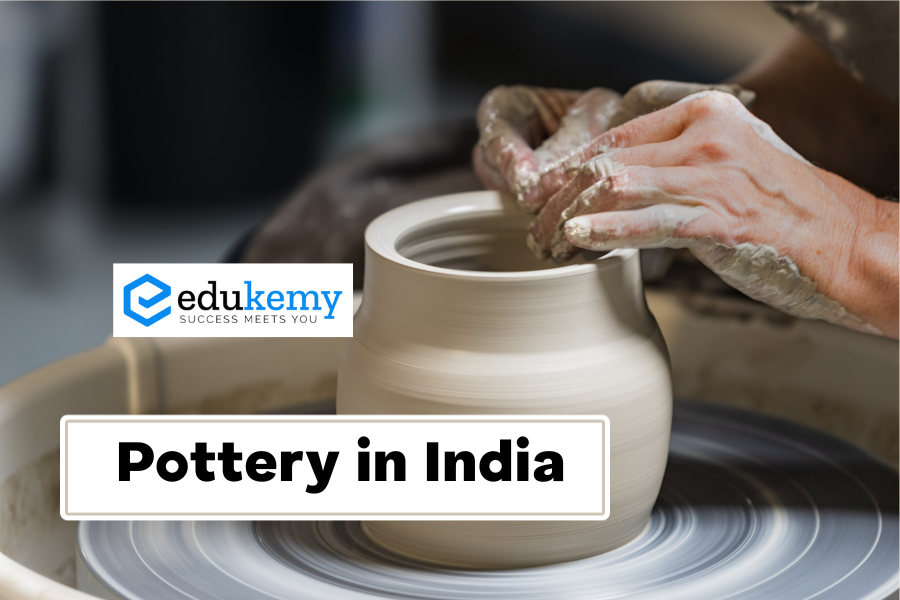The art of pottery is deeply woven into the human history, and in India, it has an exceptionally rich and diverse legacy. The evolution of pottery can be traced through several distinct periods, each marked by unique characteristics and innovations.
Highlights of significant phases such as the Ochre Colored Pottery (OCP), Black and Red Ware (BRW), and Painted Grey-Ware (PGW)
Contents
- 1 Neolithic Age: The Dawn of Pottery
- 2 Chalcolithic Age: Metal Meets Pottery
- 3 Harappan Civilization:
- 4 Vedic Era – Painted Grey Ware (PGW):
- 5 Later Vedic Era – Northern Black Polished Ware (NBPW):
- 6 Megalithic Era:
- 7 FAQs on Pottery in India
- 7.1 Q: What is the historical significance of pottery in India?
- 7.2 Q: What are the traditional pottery techniques practiced in different regions of India?
- 7.3 Q: How has modernization affected traditional pottery in India?
- 7.4 Q: What role does pottery play in Indian rituals and ceremonies?
- 7.5 Q: How can one support and promote the pottery traditions of India?
- 8 In case you still have your doubts, contact us on 9811333901.
Neolithic Age: The Dawn of Pottery
The Neolithic Age serves as the cradle of pottery in India, dating back to ancient times. During this era, pottery was initially crafted by hand, and as the age progressed, footwheels were introduced.
Key Features of Neolithic Age Pottery:
- Unglazed and unburnished, resulting in a rough surface.
- Handmade coarse grey pottery using clay mixed with mica and sand.
- Minimal decoration; some pottery featured twisted rice husk cords impressed into the wet clay for adornment.
- Found throughout India, including regions like South India.
Chalcolithic Age: Metal Meets Pottery
The Chalcolithic Era, also known as the first metal age, brought distinct cultures across India, each with its own pottery styles.
Notable Pottery Types in the Chalcolithic Age:
- Black and Red Ware Pottery: A widespread pottery type with white linear designs.
- Black-on-Red Ware: Pottery painted black on a red surface with a matt finish.
- Ochre Colored Pottery (OCP): OCP was linked to the Copper Hoard Culture and is characterized by pottery ranging in color from orange to red. Major OCP sites include Jodhpura (Rajasthan) and Attranjikhera (Uttar Pradesh).
Harappan Civilization:
During the Harappan Civilization, pottery reached a new level of sophistication.
Key Aspects of Harappan Pottery:
- Both polished and unpolished pottery existed, with most being wheel-thrown.
- Polychrome pottery with more than two colors used for decoration.
- Pottery included geometrical designs and paintings depicting flora and fauna.
- Presence of perforated pottery, possibly used for straining liquor.
Vedic Era – Painted Grey Ware (PGW):
The Vedic Era saw the emergence of the Painted Grey Ware (PGW) culture. The Rig Vedic sites contain PGW, although they lack iron objects and cereals, making them a pre-iron phase of PGW.
Characteristics of PGW Pottery:
- Iron Age pottery with a fine, grey fabric painted with black geometric patterns.
- Concentrated in the Gangetic plain and Ghaggar-Hakra valley.
- Associated with village and town settlements, often found in conjunction with some late Harappan pottery.
Later Vedic Era – Northern Black Polished Ware (NBPW):
In the very late Later Vedic Age around the 6th century BC, the Northern Black Polished Ware (NBPW) emerged, marking the second phase of urbanization.
Notable Features of NBPW:
- Characterized by glossy, shining pottery made of fine fabric.
- Served as tableware for the elite and reflected societal Brahmanical stratification.
- Found in Ahichatra and Hastinapur (Uttar Pradesh), Navdatoli (Madhya Pradesh).
- Classified into two groups: monochrome and bichrome, with monochrome pottery being jet black and other colors, while bichrome showed a combination of two colors.
Megalithic Era:
The Megalithic Era, spanning from the 3rd century BC to the 1st century AD, was characterized by large stone graves and the use of iron in South India.
Key Elements of Megalithic Pottery:
- Well-baked and durable wheel-thrown pottery, mostly plain.
- Some pottery revealed black painting on the surface.
- Used as grave goods, emphasizing belief in life after death.
- Major excavations in regions like the Vindhyas.
The evolution of pottery in India is evident to the nation’s rich cultural and historical heritage. Each period brought forth distinct pottery styles, reflecting the society’s advancement and changing needs. Pottery in India is more than just an art form; it’s a historical journey of innovation and artistic expression.
FAQs on Pottery in India
Q: What is the historical significance of pottery in India?
Pottery in India has a rich historical significance, dating back to ancient civilizations such as the Indus Valley Civilization. The craft has evolved over millennia, influencing cultural practices, trade, and daily life. Understanding the historical context provides insights into the diverse styles and techniques seen in contemporary Indian pottery.
Q: What are the traditional pottery techniques practiced in different regions of India?
India boasts a diverse range of pottery techniques, each unique to its region. For example, the blue pottery of Jaipur, the terracotta work of West Bengal, and the black pottery of Manipur. Exploring these regional techniques not only showcases the cultural diversity but also highlights the adaptability of the craft across the country.
Q: How has modernization affected traditional pottery in India?
With the advent of modern technologies and changing lifestyles, traditional pottery in India has faced challenges. Many potters are adapting to contemporary tastes and markets while striving to preserve the authenticity of their craft. Understanding the dynamics of this transition sheds light on the balance between preserving cultural heritage and meeting modern demands.
Q: What role does pottery play in Indian rituals and ceremonies?
Pottery holds cultural and religious significance in India, playing a vital role in various rituals and ceremonies. From the creation of ceremonial pots to the use of specific forms in religious practices, pottery is deeply embedded in the fabric of Indian traditions. Exploring this aspect provides insights into the spiritual and symbolic dimensions of the craft.
Q: How can one support and promote the pottery traditions of India?
Individuals interested in supporting Indian pottery traditions can take various steps. This may include purchasing pottery directly from artisans, promoting awareness of traditional techniques, and participating in initiatives that aim to preserve and revive the craft. Understanding how to contribute to the sustainability of Indian pottery ensures the continuation of this cultural heritage for future generations.
In case you still have your doubts, contact us on 9811333901.
For UPSC Prelims Resources, Click here
For Daily Updates and Study Material:
Join our Telegram Channel – Edukemy for IAS
- 1. Learn through Videos – here
- 2. Be Exam Ready by Practicing Daily MCQs – here
- 3. Daily Newsletter – Get all your Current Affairs Covered – here
- 4. Mains Answer Writing Practice – here


